Effects of number of simulated particles on the uncertainty in simulation of dispersion of radioactive material using FLEXPART program
FLEXPART software simulates atmospheric emissions based on wind-field movements and
random disturbances. To simulate random processes, FLEXPART uses a certain number of simulation
particles. Changing the number of simulation particles causes a change in the simulated results of the
dispersion concentration of the radionuclides. The larger number of simulated particles results in the
more accurate simulated results. However, increasing the number of simulated particles results in the
increasing of the computational cost. The report presents an assessment of the uncertainty in the
concentration of radionuclides in simulating dispersion of 137Cs and 131I nuclides using FLEXPART
software according to the number of simulation particles. The number of simulation particles used in
this study are 100, 1000, 5000, 7500, 10000, 15000, 20000, 25000 and 30000 particles / hour. Using
the image processing software OpenCV to evaluate the uncertainties of simulated results according to
the number of simulated particles used. Evaluation results show that the simulated results are
acceptable with the number of simulated particles being of 20000 particles/hour.
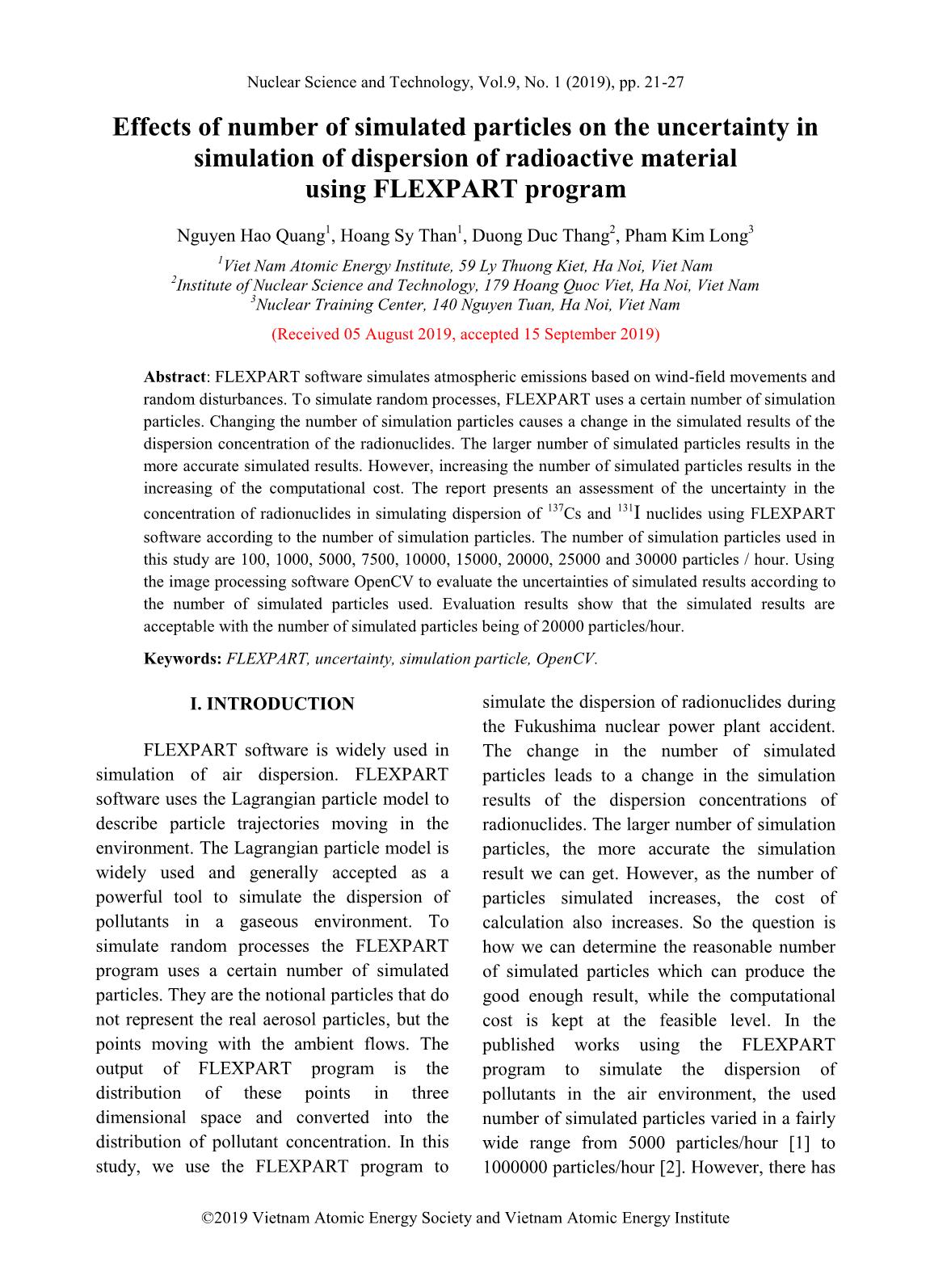
Trang 1
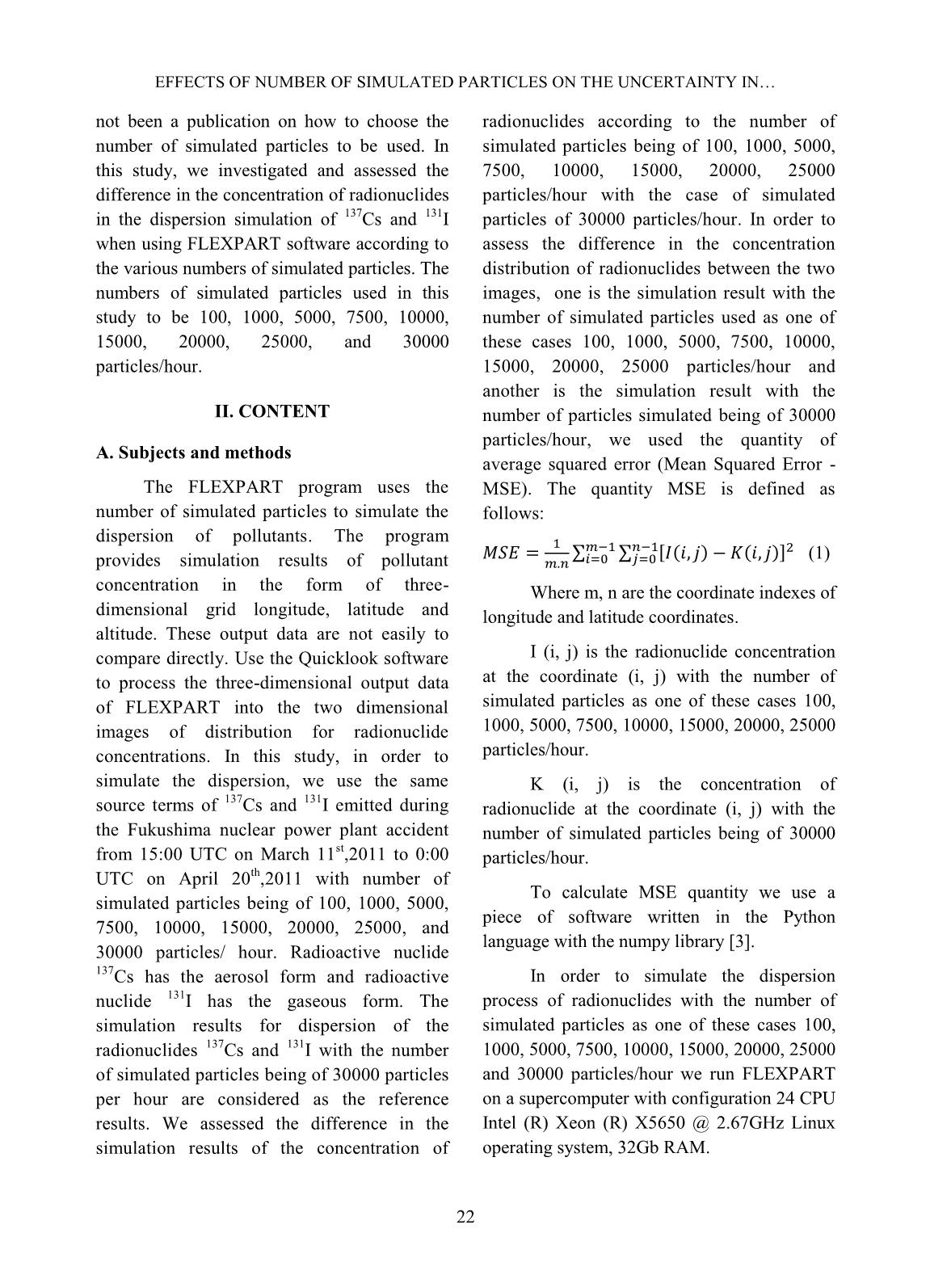
Trang 2
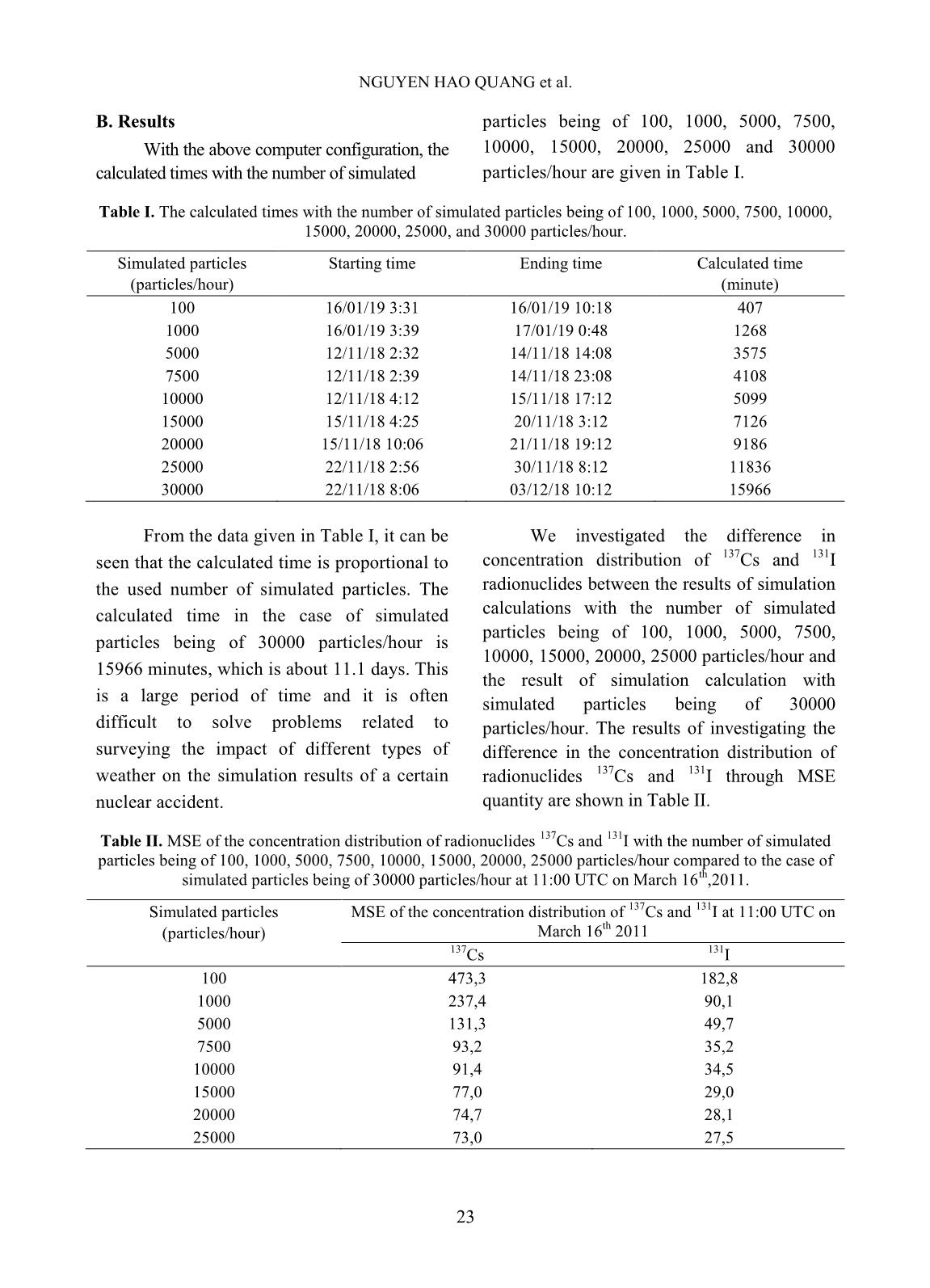
Trang 3
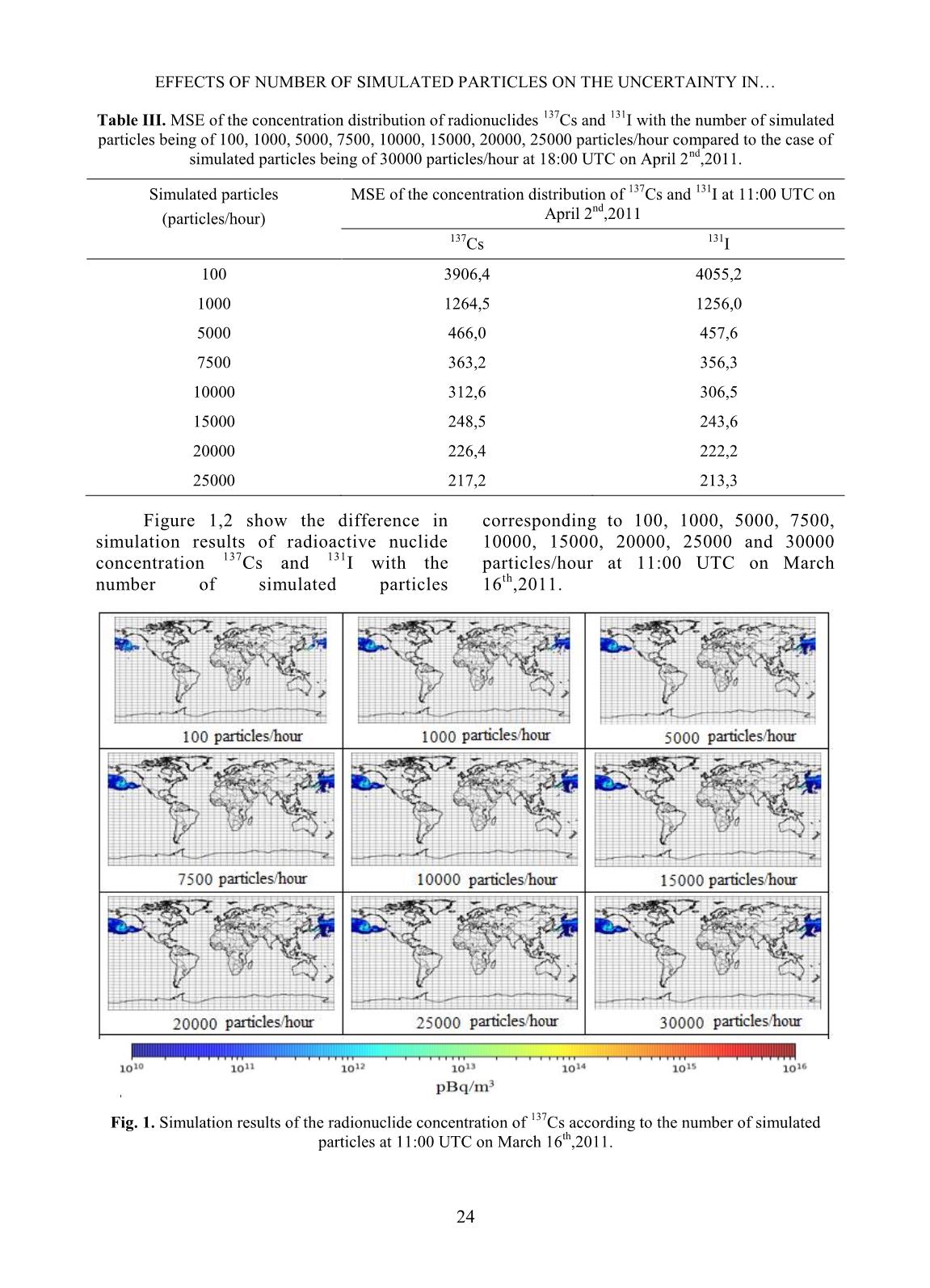
Trang 4
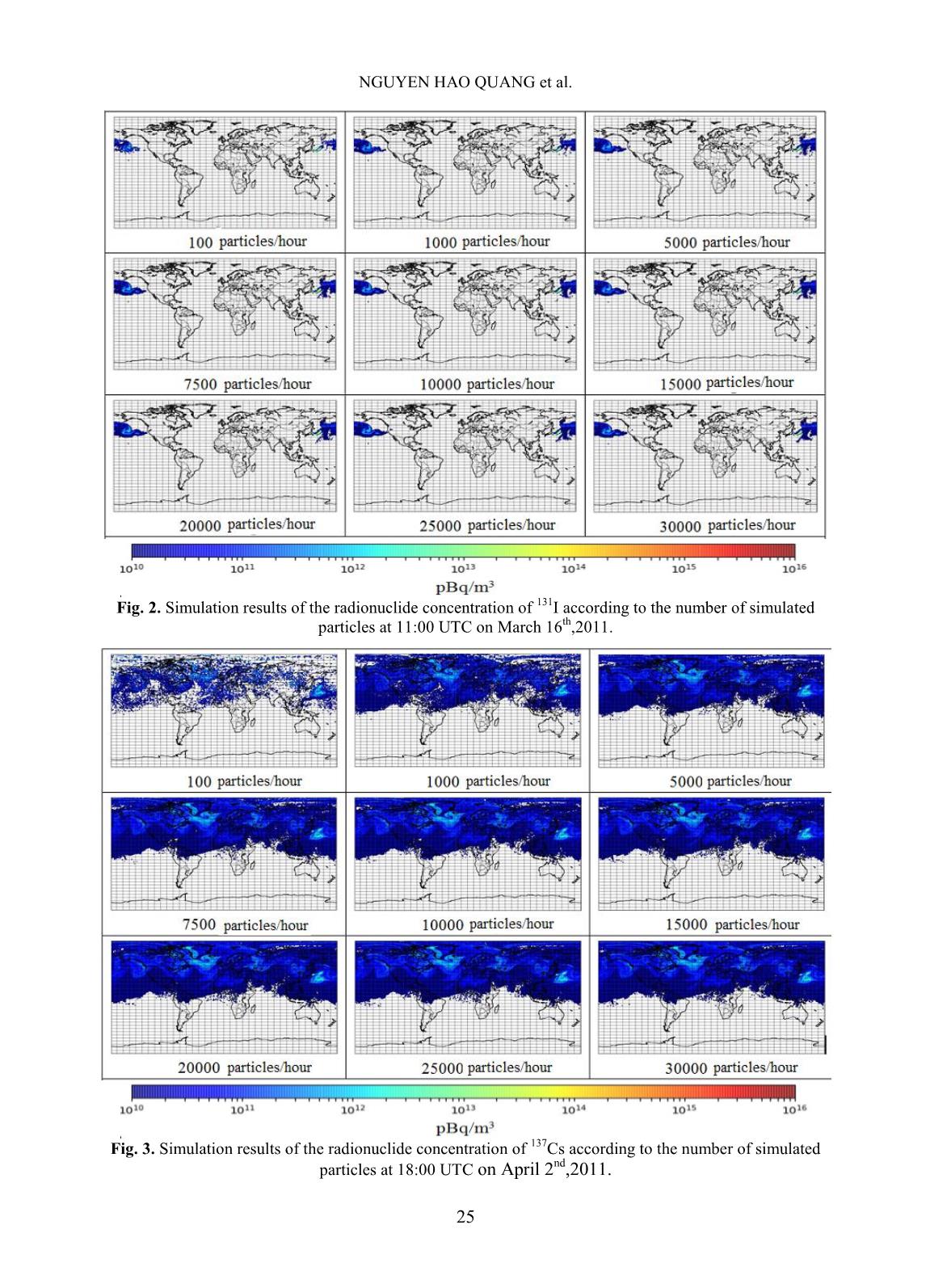
Trang 5
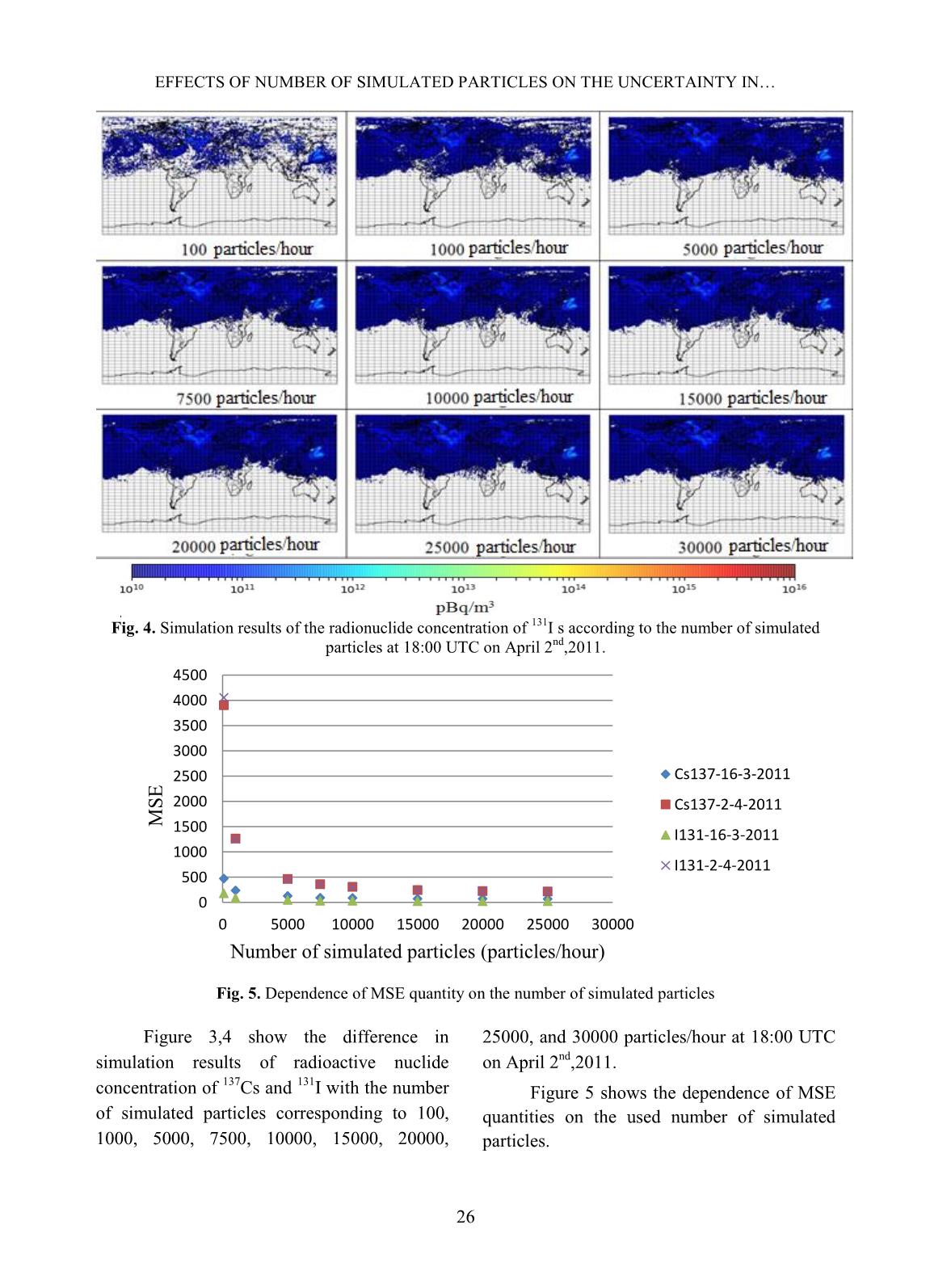
Trang 6
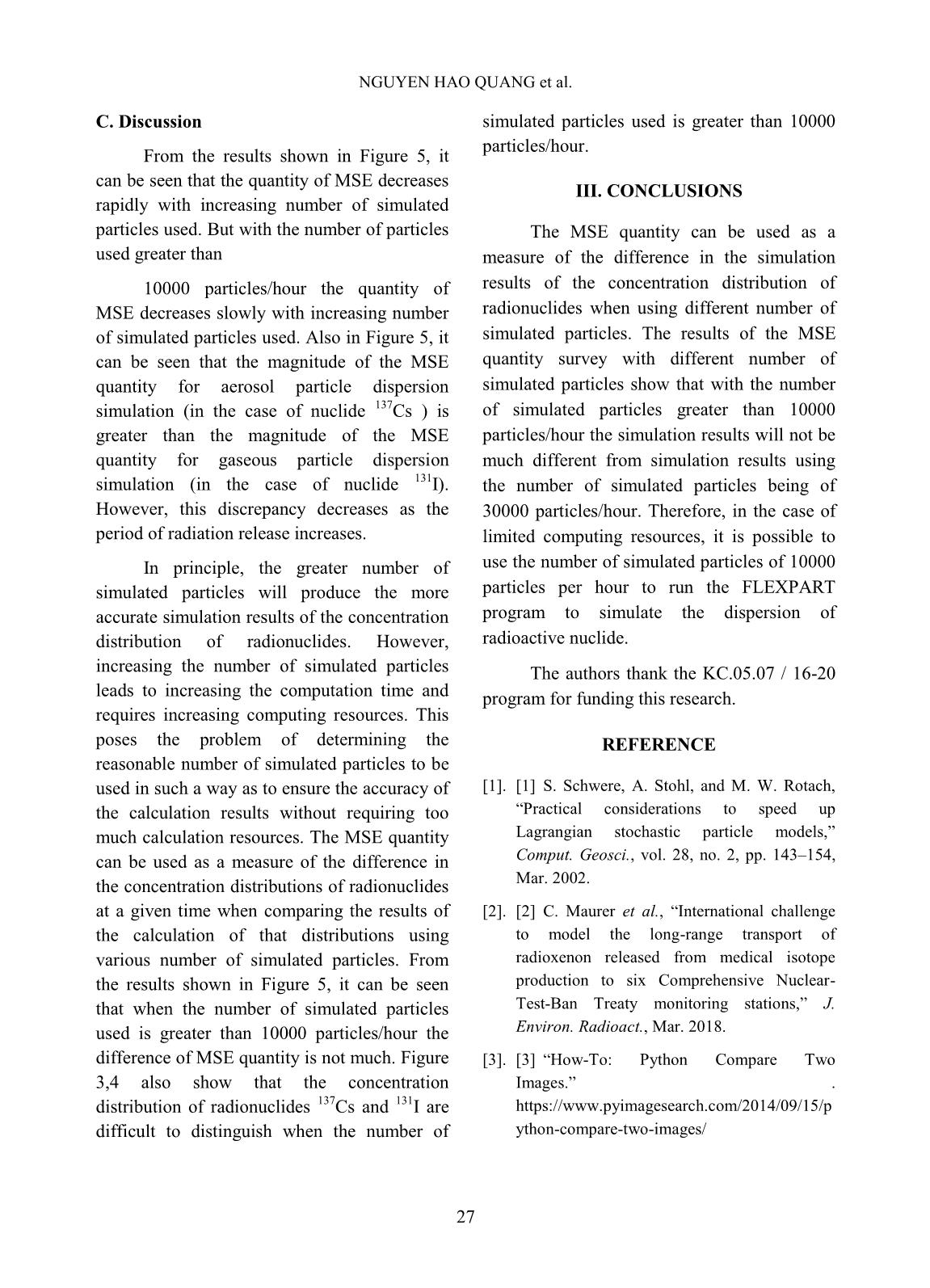
Trang 7
Tóm tắt nội dung tài liệu: Effects of number of simulated particles on the uncertainty in simulation of dispersion of radioactive material using FLEXPART program
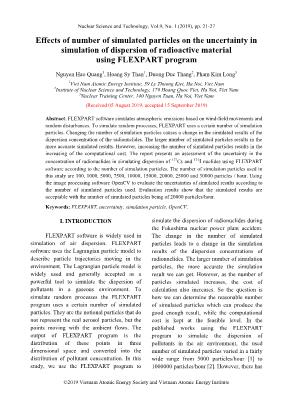
Technology, 179 Hoang Quoc Viet, Ha Noi, Viet Nam 3 Nuclear Training Center, 140 Nguyen Tuan, Ha Noi, Viet Nam (Received 05 August 2019, accepted 15 September 2019) Abstract: FLEXPART software simulates atmospheric emissions based on wind-field movements and random disturbances. To simulate random processes, FLEXPART uses a certain number of simulation particles. Changing the number of simulation particles causes a change in the simulated results of the dispersion concentration of the radionuclides. The larger number of simulated particles results in the more accurate simulated results. However, increasing the number of simulated particles results in the increasing of the computational cost. The report presents an assessment of the uncertainty in the concentration of radionuclides in simulating dispersion of 137 Cs and 131I nuclides using FLEXPART software according to the number of simulation particles. The number of simulation particles used in this study are 100, 1000, 5000, 7500, 10000, 15000, 20000, 25000 and 30000 particles / hour. Using the image processing software OpenCV to evaluate the uncertainties of simulated results according to the number of simulated particles used. Evaluation results show that the simulated results are acceptable with the number of simulated particles being of 20000 particles/hour. Keywords: FLEXPART, uncertainty, simulation particle, OpenCV. I. INTRODUCTION FLEXPART software is widely used in simulation of air dispersion. FLEXPART software uses the Lagrangian particle model to describe particle trajectories moving in the environment. The Lagrangian particle model is widely used and generally accepted as a powerful tool to simulate the dispersion of pollutants in a gaseous environment. To simulate random processes the FLEXPART program uses a certain number of simulated particles. They are the notional particles that do not represent the real aerosol particles, but the points moving with the ambient flows. The output of FLEXPART program is the distribution of these points in three dimensional space and converted into the distribution of pollutant concentration. In this study, we use the FLEXPART program to simulate the dispersion of radionuclides during the Fukushima nuclear power plant accident. The change in the number of simulated particles leads to a change in the simulation results of the dispersion concentrations of radionuclides. The larger number of simulation particles, the more accurate the simulation result we can get. However, as the number of particles simulated increases, the cost of calculation also increases. So the question is how we can determine the reasonable number of simulated particles which can produce the good enough result, while the computational cost is kept at the feasible level. In the published works using the FLEXPART program to simulate the dispersion of pollutants in the air environment, the used number of simulated particles varied in a fairly wide range from 5000 particles/hour [1] to 1000000 particles/hour [2]. However, there has EFFECTS OF NUMBER OF SIMULATED PARTICLES ON THE UNCERTAINTY IN 22 not been a publication on how to choose the number of simulated particles to be used. In this study, we investigated and assessed the difference in the concentration of radionuclides in the dispersion simulation of 137 Cs and 131 I when using FLEXPART software according to the various numbers of simulated particles. The numbers of simulated particles used in this study to be 100, 1000, 5000, 7500, 10000, 15000, 20000, 25000, and 30000 particles/hour. II. CONTENT A. Subjects and methods The FLEXPART program uses the number of simulated particles to simulate the dispersion of pollutants. The program provides simulation results of pollutant concentration in the form of three- dimensional grid longitude, latitude and altitude. These output data are not easily to compare directly. Use the Quicklook software to process the three-dimensional output data of FLEXPART into the two dimensional images of distribution for radionuclide concentrations. In this study, in order to simulate the dispersion, we use the same source terms of 137 Cs and 131 I emitted during the Fukushima nuclear power plant accident from 15:00 UTC on March 11 st ,2011 to 0:00 UTC on April 20 th ,2011 with number of simulated particles being of 100, 1000, 5000, 7500, 10000, 15000, 20000, 25000, and 30000 particles/ hour. Radioactive nuclide 137 Cs has the aerosol form and radioactive nuclide 131 I has the gaseous form. The simulation results for dispersion of the radionuclides 137 Cs and 131 I with the number of simulated particles being of 30000 particles per hour are considered as the reference results. We assessed the difference in the simulation results of the concentration of radionuclides according to the number of simulated particles being of 100, 1000, 5000, 7500, 10000, 15000, 20000, 25000 particles/hour with the case of simulated particles of 30000 particles/hour. In order to assess the difference in the concentration distribution of radionuclides between the two images, one is the simulation result with the number of simulated particles used as one of these cases 100, 1000, 5000, 7500, 10000, 15000, 20000, 25000 particles/hour and another is the simulation result with the number of particles simulated being of 30000 particles/hour, we used the quantity of average squared error (Mean Squared Error - MSE). The quantity MSE is defined as follows: ∑ ∑ [ ( ) ( )] (1) Where m, n are the coordinate indexes of longitude and latitude coordinates. I (i, j) is the radionuclide concentration at the coordinate (i, j) with the number of simulated particles as one of these cases 100, 1000, 5000, 7500, 10000, 15000, 20000, 25000 particles/hour. K (i, j) is the concentration of radionuclide at the coordinate (i, j) with the number of simulated particles being of 30000 particles/hour. To calculate MSE quantity we use a piece of software written in the Python language with the numpy library [3]. In order to simulate the dispersion process of radionuclides with the number of simulated particles as one of these cases 100, 1000, 5000, 7500, 10000, 15000, 20000, 25000 and 30000 particles/hour we run FLEXPART on a supercomputer with configuration 24 CPU Intel (R) Xeon (R) X5650 @ 2.67GHz Linux operating system, 32Gb RAM. NGUYEN HAO QUANG et al. 23 B. Results With the above computer configuration, the calculated times with the number of simulated particles being of 100, 1000, 5000, 7500, 10000, 15000, 20000, 25000 and 30000 particles/hour are given in Table I. Table I. The calculated times with the number of simulated particles being of 100, 1000, 5000, 7500, 10000, 15000, 20000, 25000, and 30000 particles/hour. Simulated particles (particles/hour) Starting time Ending time Calculated time (minute) 100 16/01/19 3:31 16/01/19 10:18 407 1000 16/01/19 3:39 17/01/19 0:48 1268 5000 12/11/18 2:32 14/11/18 14:08 3575 7500 12/11/18 2:39 14/11/18 23:08 4108 10000 12/11/18 4:12 15/11/18 17:12 5099 15000 15/11/18 4:25 20/11/18 3:12 7126 20000 15/11/18 10:06 21/11/18 19:12 9186 25000 22/11/18 2:56 30/11/18 8:12 11836 30000 22/11/18 8:06 03/12/18 10:12 15966 From the data given in Table I, it can be seen that the calculated time is proportional to the used number of simulated particles. The calculated time in the case of simulated particles being of 30000 particles/hour is 15966 minutes, which is about 11.1 days. This is a large period of time and it is often difficult to solve problems related to surveying the impact of different types of weather on the simulation results of a certain nuclear accident. We investigated the difference in concentration distribution of 137 Cs and 131 I radionuclides between the results of simulation calculations with the number of simulated particles being of 100, 1000, 5000, 7500, 10000, 15000, 20000, 25000 particles/hour and the result of simulation calculation with simulated particles being of 30000 particles/hour. The results of investigating the difference in the concentration distribution of radionuclides 137 Cs and 131 I through MSE quantity are shown in Table II. Table II. MSE of the concentration distribution of radionuclides 137 Cs and 131 I with the number of simulated particles being of 100, 1000, 5000, 7500, 10000, 15000, 20000, 25000 particles/hour compared to the case of simulated particles being of 30000 particles/hour at 11:00 UTC on March 16 th ,2011. Simulated particles (particles/hour) MSE of the concentration distribution of 137 Cs and 131 I at 11:00 UTC on March 16 th 2011 137 Cs 131 I 100 473,3 182,8 1000 237,4 90,1 5000 131,3 49,7 7500 93,2 35,2 10000 91,4 34,5 15000 77,0 29,0 20000 74,7 28,1 25000 73,0 27,5 EFFECTS OF NUMBER OF SIMULATED PARTICLES ON THE UNCERTAINTY IN 24 Table III. MSE of the concentration distribution of radionuclides 137 Cs and 131 I with the number of simulated particles being of 100, 1000, 5000, 7500, 10000, 15000, 20000, 25000 particles/hour compared to the case of simulated particles being of 30000 particles/hour at 18:00 UTC on April 2 nd ,2011. Simulated particles (particles/hour) MSE of the concentration distribution of 137 Cs and 131 I at 11:00 UTC on April 2 nd ,2011 137 Cs 131 I 100 3906,4 4055,2 1000 1264,5 1256,0 5000 466,0 457,6 7500 363,2 356,3 10000 312,6 306,5 15000 248,5 243,6 20000 226,4 222,2 25000 217,2 213,3 Figure 1,2 show the difference in simulation results of radioactive nuclide concentration 137 Cs and 131 I with the number of simulated particles corresponding to 100, 1000, 5000, 7500, 10000, 15000, 20000, 25000 and 30000 particles/hour at 11:00 UTC on March 16 th ,2011. Fig. 1. Simulation results of the radionuclide concentration of 137 Cs according to the number of simulated particles at 11:00 UTC on March 16 th ,2011. NGUYEN HAO QUANG et al. 25 Fig. 2. Simulation results of the radionuclide concentration of 131 I according to the number of simulated particles at 11:00 UTC on March 16 th ,2011. Fig. 3. Simulation results of the radionuclide concentration of 137 Cs according to the number of simulated particles at 18:00 UTC on April 2 nd ,2011. EFFECTS OF NUMBER OF SIMULATED PARTICLES ON THE UNCERTAINTY IN 26 Fig. 4. Simulation results of the radionuclide concentration of 131 I s according to the number of simulated particles at 18:00 UTC on April 2 nd ,2011. Fig. 5. Dependence of MSE quantity on the number of simulated particles Figure 3,4 show the difference in simulation results of radioactive nuclide concentration of 137 Cs and 131 I with the number of simulated particles corresponding to 100, 1000, 5000, 7500, 10000, 15000, 20000, 25000, and 30000 particles/hour at 18:00 UTC on April 2 nd ,2011. Figure 5 shows the dependence of MSE quantities on the used number of simulated particles. 0 500 1000 1500 2000 2500 3000 3500 4000 4500 0 5000 10000 15000 20000 25000 30000 M S E Number of simulated particles (particles/hour) Cs137-16-3-2011 Cs137-2-4-2011 I131-16-3-2011 I131-2-4-2011 NGUYEN HAO QUANG et al. 27 C. Discussion From the results shown in Figure 5, it can be seen that the quantity of MSE decreases rapidly with increasing number of simulated particles used. But with the number of particles used greater than 10000 particles/hour the quantity of MSE decreases slowly with increasing number of simulated particles used. Also in Figure 5, it can be seen that the magnitude of the MSE quantity for aerosol particle dispersion simulation (in the case of nuclide 137 Cs ) is greater than the magnitude of the MSE quantity for gaseous particle dispersion simulation (in the case of nuclide 131 I). However, this discrepancy decreases as the period of radiation release increases. In principle, the greater number of simulated particles will produce the more accurate simulation results of the concentration distribution of radionuclides. However, increasing the number of simulated particles leads to increasing the computation time and requires increasing computing resources. This poses the problem of determining the reasonable number of simulated particles to be used in such a way as to ensure the accuracy of the calculation results without requiring too much calculation resources. The MSE quantity can be used as a measure of the difference in the concentration distributions of radionuclides at a given time when comparing the results of the calculation of that distributions using various number of simulated particles. From the results shown in Figure 5, it can be seen that when the number of simulated particles used is greater than 10000 particles/hour the difference of MSE quantity is not much. Figure 3,4 also show that the concentration distribution of radionuclides 137 Cs and 131 I are difficult to distinguish when the number of simulated particles used is greater than 10000 particles/hour. III. CONCLUSIONS The MSE quantity can be used as a measure of the difference in the simulation results of the concentration distribution of radionuclides when using different number of simulated particles. The results of the MSE quantity survey with different number of simulated particles show that with the number of simulated particles greater than 10000 particles/hour the simulation results will not be much different from simulation results using the number of simulated particles being of 30000 particles/hour. Therefore, in the case of limited computing resources, it is possible to use the number of simulated particles of 10000 particles per hour to run the FLEXPART program to simulate the dispersion of radioactive nuclide. The authors thank the KC.05.07 / 16-20 program for funding this research. REFERENCE [1]. [1] S. Schwere, A. Stohl, and M. W. Rotach, “Practical considerations to speed up Lagrangian stochastic particle models,” Comput. Geosci., vol. 28, no. 2, pp. 143–154, Mar. 2002. [2]. [2] C. Maurer et al., “International challenge to model the long-range transport of radioxenon released from medical isotope production to six Comprehensive Nuclear- Test-Ban Treaty monitoring stations,” J. Environ. Radioact., Mar. 2018. [3]. [3] “How-To: Python Compare Two Images.” . https://www.pyimagesearch.com/2014/09/15/p ython-compare-two-images/
File đính kèm:
 effects_of_number_of_simulated_particles_on_the_uncertainty.pdf
effects_of_number_of_simulated_particles_on_the_uncertainty.pdf

